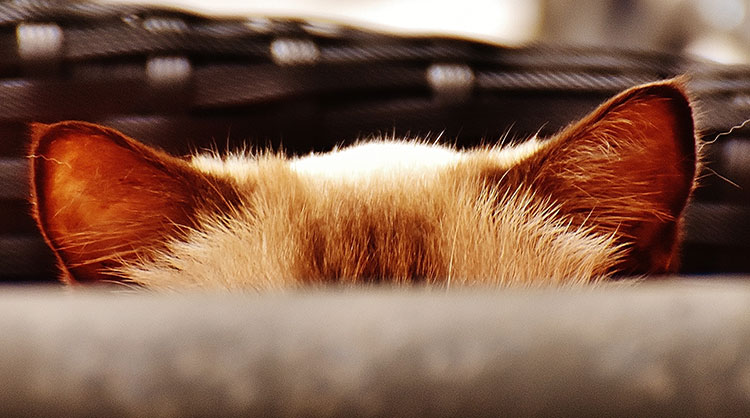How to Effectively Combat Ear Mites in Cats
Your kitty can say goodbye to itchy ears, thanks to Bravecto® effectively treating ear mites in cats. Put a stop to external parasites in a flash!
CATS EAR MITES

Posted by bravectosouthafrica – 23 October 2019
The Scratchy Situation: Ear Mites on Cats
Ear mites (scientific name: Otodectes cynotis) are one of the most common parasitic infestations known to plague cats. Your cat can catch mites from dogs or other animals they may come in frequent contact with.
Because of these pesky parasites’ microscopic size, it can be hard to pinpoint the problem. The tell-tale sign of an ear mite infestation is your cat constantly scratching their ears or shaking their heads. Other signs could include:
- Inflamed ears
- Excessive wax production because of irritation
- Black debris, resembling coffee grounds, in the ears
- Strange smell
If the infestation is serious enough, you may be able to see the ear mites, resembling minute white specs, inside your cat’s ears.
To get a clear diagnosis, a veterinarian will take a swab of the inside of your cat’s ear and inspect it underneath a microscope.
It is crucial for you to get a correct diagnosis from a certified veterinarian, as your cat’s excessive ear scratching and head shaking may lead to numerous other health complications, such as:
- Formation of haematoma within the ear
- Damage to ear canals
- Damage to eardrums
Without the right treatment, your cat could suffer temporary or even permanent hearing loss.
Remember to take any changes in your cat’s health seriously and seek medical help as soon as possible.
Ear Mites in Kittens – Not Just an Adult Problem
Ear mites can affect cats in any life phase, not just adults. Your new kitten is also susceptible to this parasitic infestation. Be especially mindful of the fact that ear mites are extremely contagious and can easily spread from parent to kitten, as well as between different animal species.
The parasite is also known to eventually spread well beyond the ears to the skin, head, neck, back and tail. This could lead to a far more serious infestation, should the problem not be nipped in the bud early on. The untreated presence of ear mites can lead your kitten to develop secondary fungal or bacterial infections.
Be mindful of the fact that, although cats of all ages can suffer from ear mites, kittens are the most likely targets.

The Symptoms of Ear Mites in Cats
If your cat is exhibiting any of the following symptoms, take them to a vet promptly to get a clear diagnosis and the right treatment:
- Constantly scratching at their ears, head and neck
- Excessive scratching in general
- Regular head shaking
- Black or reddish-brown crusts formed around the outside of the ears
- A discharge resembling coffee grounds in their ear canal
- Scratch marks or signs of chafing on the back of their ears
- Signs of crusting and scaling on their neck, backside or tail
Be sure to give your vet a detailed account of what symptoms your cat has been exhibiting, as well as when they started. Also remember to tell your vet if your cat could have come into contact with any other animals or if they regularly spend time outside.
Seeing a trained vet is very important in order to get a correct diagnosis. Other causes that display similar symptoms include allergies, tumours or diseases of the endocrine system – but don’t jump to any conclusions. Early detection and treatment is the best course of action, leaving your cat with the best possible prognosis.
Should the cause of your cat’s irritation, in fact, be ear mites, treatment will usually be twofold. Firstly, a thorough cleansing of your feline friend’s ear canal will be required. Carefully remove any excess wax or discharge – it’s best to leave this to a vet to avoid further irritation or damage.
Your veterinarian will ordinarily prescribe your cat a topical solution. It may be necessary to treat all other pets in your household as well because ear mites are so contagious. Also be sure to clean your cat’s environment thoroughly, to eradicate any ear mites attempting to hide. Ear mites away from a host’s body won’t survive for too long.
Because cats tend to sleep curled up into a ball, their tails are often tucked close to their faces. For this reason, make sure to clean off their tail too, as part of the treatment.

What Are Common Ear Mite Treatments for Cats?
There are a wide variety of ear mite treatment options available, should your cat be diagnosed with an infestation. Preventative, proactive treatment, however, is key in ensuring that your cat remains mite free.
Spot-on treatments are ever popular in treating ear mites. Ear drops are also frequently prescribed. A lot of these treatments take a minimum of three weeks to get the situation under control, because the medication can’t kill the mite’s eggs.
It takes an ear mite approximately 21 days to grow into an adult, from its egg phase. Only then are they able to be killed by certain treatments. This is why it is of the utmost importance to follow your vet’s exact directions in administering the specific treatment for the full duration of time specified. If not, the infestation may well flare up again.
Your vet knows best, so be sure to use the treatment they recommended and follow their instructions to a T.
It isn’t recommended to make use of any home remedies when trying to rid your cat of an ear mite infestation. Home remedies oftentimes have to be applied daily, for long periods of time, in order to be effective. This can cause your cat prolonged suffering and distress. Also, applying an incorrect treatment can cause the real condition to severly worsen and may leave your precious feline with lasting ear damage.
The longer ear mites are left untreated, the more harm is caused – not just to your cat, but any other pets in the household as well. As touched upon earlier, ear mites are extremely contagious and are easily transferred from one host to the next via close physical contact. Your dog, bunny and even hamster can become the next target. Should your cat be diagnosed with ear mites, it is important for you to seek treatment for all other pets in your household as well. Your vet will be happy to help you identify the best course of treatment for each pet.
Bravecto® is a fantastic long-term solution for treating ticks, fleas and ear mites – all in one convenient dose. No matter whether you have an indoor or outdoor cat, protection against external parasites is important for their continued wellbeing.
Bravecto® Spot-On for Cats is effective, safe and easy to use. Not only is Bravecto® vet-approved and recommended, but it is also proven to be safe for cats that weigh at least 1,2 kg and for kittens older than 11 weeks.
To apply, simply part the hair at the nape of your cat’s neck and squeeze out the product from the convenient Twist’n’Use™ applicator onto the exposed skin.
The best part? You only have to apply a single dose once every 3 months. That’s long term and cost-effective protection in a single dose.
Get rid of an existing tick, flea or ear mite infestation, or simply maintain a parasite-free feline with Bravecto® Spot-On for Cats.
Ask your vet about Bravecto® for the treatment of ear mites in your cat today.

How to Get Rid of Ear Mites in Your Home
After getting your feline friend treated for ear mites, you might want to consider giving your house a proper and thorough cleaning. Ear mites can survive for up to 6 days without a host, so these pesky parasites might still be lurking in your carpet or on your couch. Everywhere your cat has shed becomes a potential hideaway for more mites.
You’ll want to:
- Wash all of your cat’s bedding on the hottest cycle (you can use normal detergent).
- If you are able to, have all of the carpets in your house washed. If not, be extremely thorough in vacuuming them.
- After vacuuming, be sure to sprinkle a parasite killing powder on all carpeted surfaces. Be sure to look for one that is safe for both children and pets. You’ll have to let it sit for a certain amount of time – depending on the brand – before vacuuming again.
- Repeat the entire process again in two weeks’ time, to be sure all mites have been eliminated.
Following this process will ensure that your house is mite-free and the chance of reinfestation is significantly reduced.
Bravecto® to the Rescue: The Best Ear Mite Medicine for Cats
As you can see, there are multiple treatment options available on the market, but when it comes to preventative and long-lasting protection, there’s none quite like Bravecto® Spot-On for Cats. A single dose will ensure that your feline friend remains tick, flea and ear mite free for 3 whole months. That’s 3x longer than the competition!
Afraid you’ll forget when to re-dose your cat? Download the convenient Bravecto® reminder app. Simply create a profile for your pet after downloading, enter the date that you last administered a dose and our nifty reminder app will notify you when your beloved furball’s next dose is due.
Take your cat’s health into your hands today, whether they’re already suffering from an ear mite infestation or you want to prevent one – buy Bravecto® Spot-On for Cats and see the difference today!
Follow this link if you would like to find out more about the symptoms of a sick cat.
Subscribe to our Newsletter
Get to know your furry friend better! Sign up for all things dog- or cat-related.
The Hairy Facts about the dreaded hairball
12 April 2021
Help! My dog’s barking mad! Volume 2
12 April 2021
Your Itchy, Scratchy Cat – All About Cat Skin Problems
12 April 2021
The Dog’s Diet: A Bone of contention?
01 April 2021
Mango Fly Worms: How to Spot and Eliminate them
Posted on November 28,2019
Managing Mange And Mites In Your Dog
Posted on June 11,2018
Why Do Cats Purr and How? Learn What Your Cat Is Saying
Posted on October 14,2020
How to Get Rid of Ear Mites in Dogs
Posted on November 06,2019









